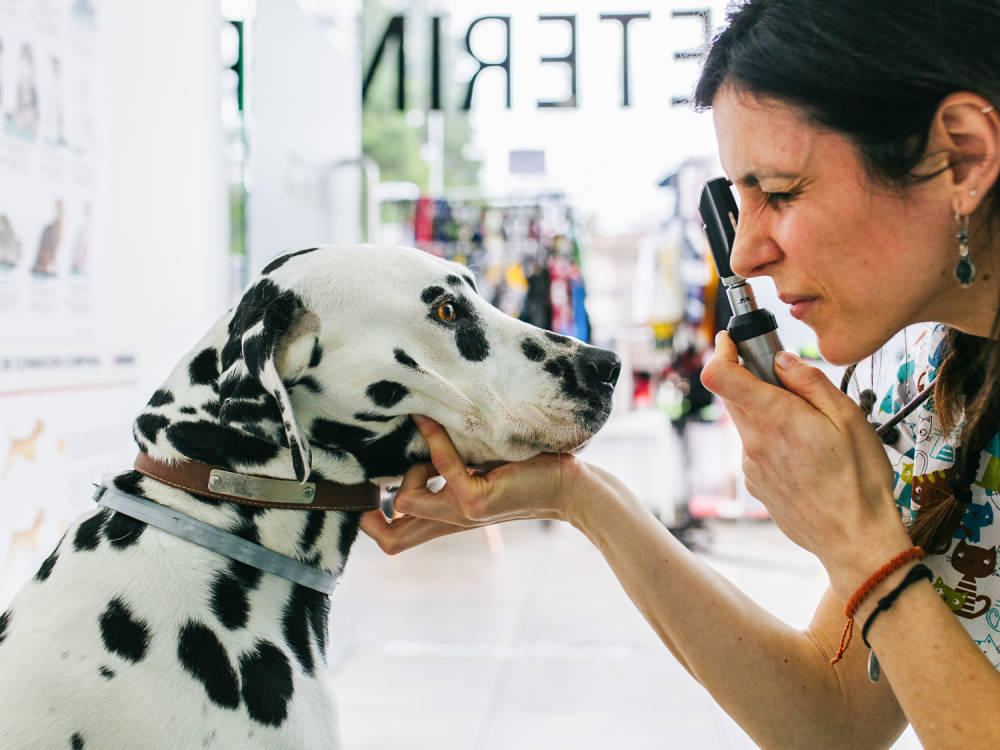How to Spot, Treat, and Prevent Diabetes in Your Dog
Learn which breeds are at risk, the symptoms to look out for, and what treatment options are available.

share article
In this Article:
What Is Diabetes?opens in a new tab Causes of Diabetes in Dogsopens in a new tab Symptoms and Diagnosis of Diabetes In Dogs opens in a new tab Risk Factors For Diabetes in Dogsopens in a new tab Treatment For Dog Diabetesopens in a new tab Living With a Diabetic Dogopens in a new tab
Diabetes — when your body struggles to convert food into energy — isn’t limited to people. It can happen to dogs, too. In fact, researchers estimate that one in 200 dogs will develop diabetes.
The good news is diabetes in dogs can be successfully treated and managed. Recent advances in medicine have made it possible for diabetic dogs to live a long, healthy life. Phew! So, if your dog was recently diagnosed with the disease, don’t panic. Check out the helpful guide below to learn the types of diabetes in dogs, risk factors, symptoms, treatments, and more.
What is diabetes, exactly?
Just as cars use gas for fuel, body cells run on a sugar called glucose. The body obtains glucose by breaking down carbohydrates in the diet. Cells then extract glucose from the blood with the help of insulin, a hormone made by the pancreas in specialized cells called beta cells. (The pancreas, an organ situated behind the stomach, produces several hormones.)
Diabetes mellitus (also called insulin-dependent diabetes mellitus or referred to as type 1 diabetesopens in a new tab) is the most common type of diabetes in dogs. In diabetes mellitus, cells don’t take in enough glucose, which then builds up in the blood. As a result, cells starve, and organs bathed in sugary blood are damaged. Diabetes in dogs is not curable, but it is treatable. A dog with diabetes may live many happy years after diagnosis.
Types of diabetes in dogs
You may have heard that dogs generally get type 1 diabetes, but the reality is more complicated. Although there are no universally accepted definitions of dog diabetes, the United Kingdom’s Royal Veterinary College identifies two forms: insulin-deficiency diabetes (IDD) and insulin-resistance diabetes (IRD).
Insulin-deficiency canine diabetes
In insulin-deficiency canine diabetes, also known as insulin-dependent diabetesopens in a new tab, a dog loses beta cells and no longer makes enough insulin to keep glucose levels under control. Causes include genetic defects, inflammation of the pancreas, and immune attack (like with type 1 diabetes in humans).
Insulin-resistance canine diabetes
This type of diabetes affects older, overweight dogs, usually between the ages of five and 12 yearsopens in a new tab. In insulin-resistance canine diabetes, something prevents the dog’s insulin from functioning properly. That “something” may be diestrus, pregnancy, an endocrine disease, or treatment with steroids or progesterone-like hormones. Diestrus, the most common cause of IRD, is approximately two months of high levels of progesterone (a female hormone) between periods of estrus (heat). Hormonally, diestrus resembles pregnancy, making this form of IRD similar to human gestational diabetes.
Hormone-induced canine diabetes
Just like humans, pregnant female dogs can develop temporary insulin-resistance diabetes. While this condition is rare, it can be fatal, which is one of the many reasons that veterinarians recommend spaying female dogsopens in a new tab as soon as it’s medically safe to do so.
What causes diabetes in dogs?
Although experts aren’t certain what causes the disease, there are several potential causes of dog diabetes. Insulin-dependent diabetes, the most common kind, is most likely caused by the dog’s immune system attacking the cells in the pancreas that produce insulin. The result is a loss in insulin secretion, whether total or partial. Some dogs’ bodies also may just not produce enough insulin.
Symptoms of dog diabetes
Diabetes in dogs can be a silent disease. Your vet may discover your dog’s diabetes through routine blood work and other tests. But before you visit the vet, you may notice diabetes in a dog’s early symptoms, such as:
Greater-than-normal hunger and/or thirst
Weight loss
Lack of energy
Frequent or copious urination (some dogs may start having accidents in the house)
As diabetes advances in your dog, symptoms can become more obvious and may include:
Loss of appetite
Depressed attitude
Vomiting
If the condition is not properly treated and managed, your dog’s health will be threatened, leading to severe effects such as:
Cataractsopens in a new tab (which leads to blindness)
Urinary tract infections
Seizures
Kidney failure
Enlarged liver
Ketoacidosis, a condition accompanied by symptoms that include rapid breathing, dehydration, vomiting, or sweet-smelling breathopens in a new tab
What tests do vets use to diagnose diabetes in dogs?
A blood test that measures your dog’s blood glucose level is the most common diagnostic tool, but a high glucose level does not always mean diabetes. Because other diseases sometimes raise these levels, your vet may run additional tests to rule out such causes, such as:
Radiography to look for kidney or bladder stones and pancreatitis
Thyroid testing
Testing for Cushing’s diseaseopens in a new tab
Once your dog is diagnosed with diabetes, their veterinarian will obtain a “serial blood glucose-concentration curve” by measuring their glucose level repeatedly over many hours. The results will help the vet choose an appropriate insulin, dose, and dosing schedule.
After treatment starts, your dog will need to be routinely tested to see how well the protocol is working. Most commonly, the vet will use either a fructosamine test or a glycated hemoglobin test, which reveals average control over the previous one to three weeks (fructosamine) or two to four months (glycated hemoglobin). In contrast, the daily blood glucose measurement is a snapshot, an indication of your dog’s glucose level at one specific moment.
Risk factors for diabetes in dogs
Several factors raise a dog’s risk of developing diabetes, such as age, gender, weight, and diet. Certain breeds are at higher risk of diabetes as well, so it’s important to understand your dog’s breed history to better help your veterinarian assess their risk of diabetes.
Breed
Some dog breeds are more likely to contract diabetesopens in a new tab than others, including Australian Terriers, Standard Schnauzers, Samoyeds, Miniature Schnauzers, Fox Terriers, Keeshonds, Bichons Frise, Finnish, Spitz, Cairn Terriers, Miniature Poodles, Siberian Huskies, and Toy Poodles.
Age
While diabetes can occur in dogs at any age, it most often develops during middle or old age. Dogs who are five years old or olderopens in a new tab are more likely to contract diabetes.
Gender
Female dogs and neutered male dogs are more likely than intact males to get diabetes. In fact, unspayed female dogs are twice as likely as male dogs to develop diabetes.
Weight
Obesity can make cells resistant to insulin, but it’s unclear whether it actually causes diabetes in dogs. However, an unhealthy weight is also a risk factor for pancreatitis, which can lead to diabetes, so it’s important to keep your dog at a healthy weightopens in a new tab.
Diet
A diet high in fat may contribute to pancreatitisopens in a new tab (inflamed pancreas), which is a risk factor for diabetes.
Chronic or repeated pancreatitis
If your dog suffers from chronic or repeated inflammation of the pancreas, this condition can cause severe damage to the organ and even result in diabetes.
Steroid medications
Many steroid medications for dogs can cause diabetes when used long-term. Always follow your veterinarian’s instructions when they prescribe your dog steroids.
Other health conditions
Certain health issues and conditions, like autoimmune disorders and viral diseases, may also trigger diabetes.
Genetics
Any dog, whether purebred or mixed-breed, can contract diabetes, but genetics can also have an impact on your dog’s level of risk. Just like in humans, genetics can make some dogs more prone to diabetes than others.
Treatment for dogs with diabetes
Treating diabetes is as much an art as a science. The goal of treatment is to keep your dog’s blood glucose levels close to normal — roughly between 65 and 120 mg/dl — so that your pup feels good now and is less likely to develop diabetes-related problems later.
The most common diabetic complication in dogs is cataractsopens in a new tab (clouding of the lens of the eye). Over time, dogs may also develop hardening of the arteries, kidney diseaseopens in a new tab, retina disease, or nerve disease. And because bacteria thrive on a high-sugar diet, dogs with diabetes are prone to gum, urinary, skin, and other infections. Other components of treatment include proper diet, weight loss (if your dog is overweightopens in a new tab), an exercise program, and home testing of blood glucose levels.
Insulin
With rare exceptions, dogs with diabetes need one to two daily insulin shots to survive. The insulin is injected just under the skinopens in a new tab. Your vet may prescribe a human insulin, or possibly Vetsulinopens in a new tab, which is a purified pig insulin. Insulins vary greatly in how quickly they start working, when their action peaks, how long they last, and how much they cost. Your vet will take these factors into account when choosing the best type for your dog.
Home monitoring
Weigh your diabetic dog regularly and watch for signs of excess hunger, thirst, and urination, which are indicators that their glucose levels may be too high. Regular testing of your dog’s blood glucose level can reveal problems before they become emergencies.
Glucose levels rise after meals, occasionally when your dog is sick, and when the insulin dose is too low or timed improperly. Levels drop during fasting, after exercise, and when the insulin dose is too high or timed improperly. Both too-high and too-low glucose levels can be dangerous. When interpreting the results, consider when your dog last ate, how much exercise they have had recently, when they received an insulin dose, how large the dose was, and any symptoms.
Testing involves pricking a hairless area with a lancet, collecting the blood drop that wells up, and using a small device called a blood glucose meter to measure the concentration of glucose in the sample. Many dog parents use human blood glucose meters. However, these meters tend to read low for dogs. The AlphaTRAK meter is designed for dogs and cats and requires only a tiny blood sample.
Special Diet
Researchers are still exploring what type of dietopens in a new tab is best for dogs with diabetes. Most veterinarians recommend a diet low in fat and high in fiber. Fiber slows the entrance of glucose into the blood and may satisfy your dog’s appetite sooner, so they eat less and lose more weight. Your veterinarian may recommend a prescription dog food designed for dogs with diabetes, or a homemade dietopens in a new tab developed by a veterinary nutritionist. Some dogs may refuse to eat special diets; in that case, careful choices should be made when selecting a regular dog food.
Exercise
Exercise may not only help reduce your dog’s weight, but also lower blood glucose levels. Your dog should exercise every day for about the same length of time at about the same exertion level. Consistency is important — an unusually long or vigorous exercise session can cause blood glucose levels to drop dangerously low.
Weight loss
If a dog is overweight, shedding some poundsopens in a new tab can make the cells more sensitive to insulin, which means that glucose uptake is easier. For this reason, weight loss is often a common vet recommendation for dogs diagnosed with diabetes.
Spaying
Spaying prevents female dogs from going through diestrus, which is similar to gestational diabetes in humans. When you spay your dog, you reduce their risk of diabetes, in addition to numerous other health benefits.
What are the side effects of diabetes treatment in dogs?
Insulin is often used to treat and manage diabetes in dogs, but there are potential side effects of these treatments. Keep in mind that when treating diabetes in dogs, side effects are not guaranteed and are preferable to the more severe health risks of leaving the condition untreated. Potential side effects of insulin treatment for dogs include:
Hypoglycemia (low blood sugar)
Hyperglycemia (high blood sugar)
Redness or itching at the site of the injection
Allergic reaction
Increased thirst
More frequent urination
Hunger
Living with a diabetic dog
Your veterinarian will work with you to develop a plan to manage your dog’s diabetes and keep track of their progress. When you first begin treatment, you may be visiting the vet a lot for testing and insulin adjustments, but it’s all part of finding the right solution for them.
It’s a good idea to keep a logbook to help you monitor your dog’s progress. Every day, make sure to record:
Blood glucose test results
Any ketone test results
Changes in your dog’s appetite, weight, appearance, water intake, urination frequency, or mood
Any treatment changes your veterinarian makes
A simple notebook or notes app on your phone works well. On a day-to-day basis, you want to watch out for potential issues in your diabetic dog, such as hyperglycemia and hypoglycemiaopens in a new tab.
Hyperglycemia
Hyperglycemia is when blood glucose levels rise above the top end of the recommended normal level (ask your vet what this is for your dog). Since perfect control isn’t always attainable with current methods, vets generally try to keep most dogs below 200 milligrams per deciliter. Hyperglycemia can lead to ketoacidosis (harmful levels of ketones in the blood), which qualifies as an emergency, and you should call your vet right away.
Symptoms include drinking lots of water, urinating frequently or copiously, loss of appetite, weakness, vomiting, lethargy, ketones in the urine, or, in the most serious situation, coma. Test strips are available to detect ketones in your dog’s urine, and you should report the presence of ketones to your veterinarian immediately, even if your dog has no other symptoms.
Hypoglycemia
You’ll notice a range of symptoms, including restlessness, lethargy, confusion, weakness, wobbliness, lack of coordination, shivering, sweaty paws, seizures, or coma. Test your dog’s blood glucose level if these symptoms appear. If it is below the recommended level, rub maple syrup, Karo syrup, or tube cake frosting — high-sugar foods that are quickly absorbed into the bloodstream — on your dog’s gums and the inside of their cheek. Then call your vet to report the episode and get further instructions.
Can diabetes in dogs be prevented?
Unfortunately, this condition can’t necessarily be avoided, but there are preventive measures for dog diabetes that you can take to help keep your dog healthy. Always make sure to take your dog to the vet at least once a year for a routine physical exam and blood work. For senior dogsopens in a new tab, especially those over six years, consider visiting the vet every six months. And make sure to feed your dog high-quality food and exercise them regularly to maintain a healthy weight.
The bottom line: diabetes in dogs
Modern medicine has made taking care of a diabetic dog totally doable. It might feel overwhelming at first, but once you get used to it, it becomes a routine part of the day, like taking your dog for a walk or feeding them (don’t worry: shots and blood tests will not take over your life). A diabetic pup can live a long, happy life — and so will you with them by your side.
FAQs (People also ask):
Are there complications associated with canine diabetes?
If your dog has other conditionsopens in a new tab in addition to diabetes, they may deal with extra complications with the condition. Diseases like Cushing’s disease, pancreatitis, and hypothyroidismopens in a new tab can all contribute to your dog’s symptoms and reduced health.
How often should I monitor my diabetic dog’s blood glucose levels?
Your vet will help you determine the best schedule for monitoring your dog’s blood glucose levels. Early on in treatment, you may need to monitor your dog’s levels daily, but eventually you may only need to do occasional checks of blood glucose levels in your dog.
What type of diabetes is more common in dogs?
The most common type of diabetes in dogs is diabetes mellitus, also known as insulin-dependent or insulin-deficiency canine diabetes.
What are the types of insulin for dogs?
Insulin for dogs is available in two strength levels: U-100 and U-40. Veterinarians often prescribe the brand Vetsulin, but they may also prescribe other brands, such as Lantus, Prozinc, Detemir (also known as Levemir), or NPH.
Can diabetes cause blindness in dogs?
Extremely high blood sugar, which dogs with diabetes experience, can cause cataracts in the eye. Without proper treatment or surgery, cataracts typically lead to blindness.
Can puppies have diabetes?
Diabetes most often affects dogs that are middle-aged or older, but there are some rare forms of juvenile diabetes that exist as well.
References:

Shauna S. Roberts, PhD
Shauna S. Roberts, PhD, is an award-winning science and medical writer and copyeditor who specializes in arthritis, diabetes and related subjects.
Related articles
![Border Collie digging into a plate of dog food while seated at a yellow table]() opens in a new tab
opens in a new tabHow You Can Easily Manage Your Dog’s Weight
Keep your pup’s weight down, and you could add years to their life. What’s better than that?
![Young Man With Retriever Puppy]() opens in a new tab
opens in a new tabWhen Should You Spay or Neuter Your Dog?
The research is confusing – here are some guidelines
![Brown Labrador lifting front leg]() opens in a new tab
opens in a new tabHow to Get a Head Start on Your Pet’s Health
Spot lumps, limps, and lethargy early on.
![black scruffy dog wearing cone recovering from spay surgery]() opens in a new tab
opens in a new tabEverything You Need to Know About Spaying and Neutering Your Dog
A vet’s take on why it’s a smart choice. Snip, snip!
![woman with red hair holds senior Pomeranian dog]() opens in a new tab
opens in a new tabHow to Take Care of a Senior Dog
As dogs age, it’s important to recognize both physical and mental changes they may be experiencing.
![A dog sitting comfortably on a women's lap.]() opens in a new tab
opens in a new tab1 in 10 Dogs Will Get Kidney Disease. Here’s What to Do
It can’t be cured, but it can be managed. Partnering with your vet will be the key.











